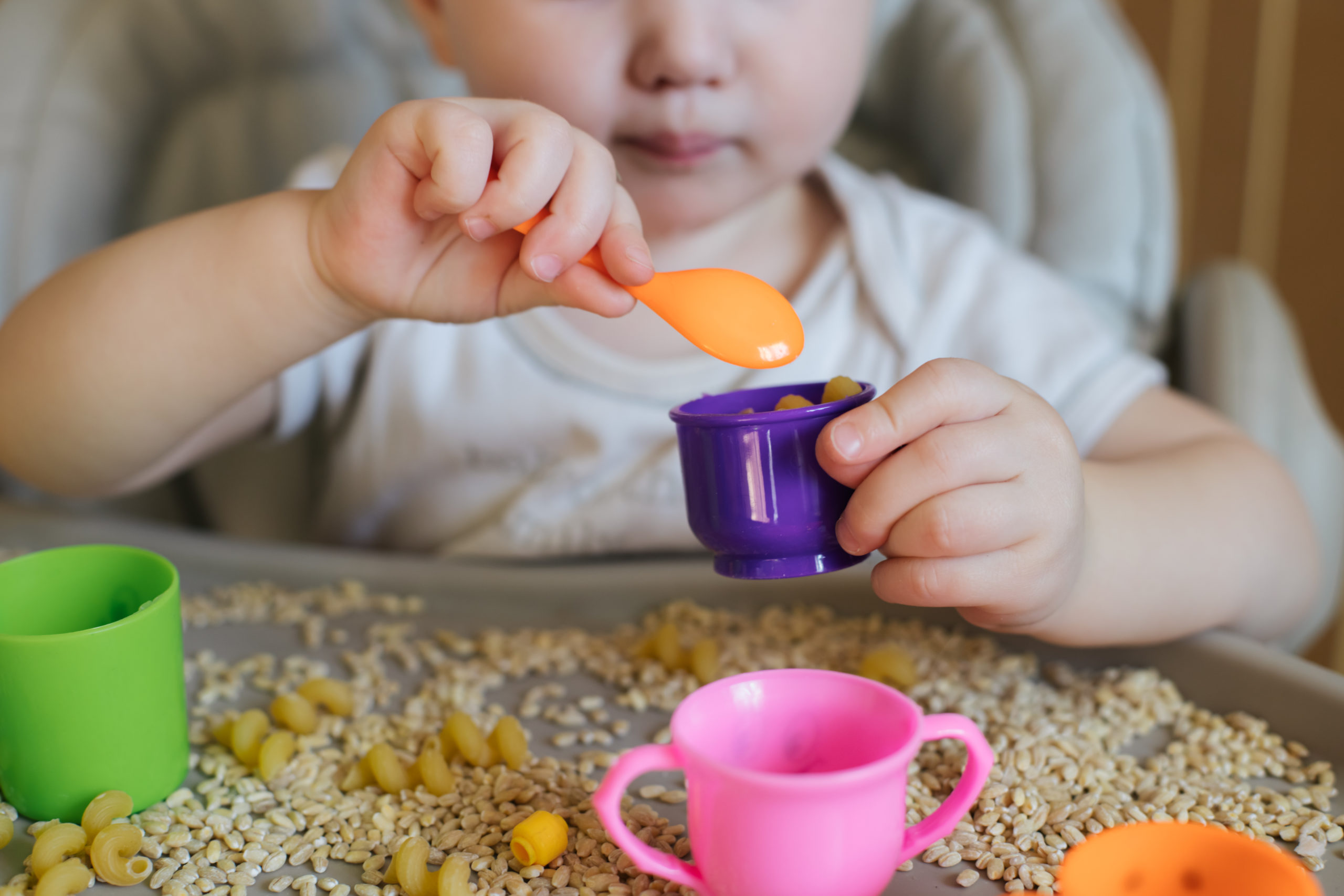As occupational therapists (OT’s), one of the many areas that we target during intervention is promoting and enhancing self-care/ adaptive skills. Mealtime success can be challenging for children that struggle with decreased fine motor skills, eye-hand coordination skills, poor body awareness, difficulty with seated posture and positioning, and decreased bimanual skills (ability to use two hands at the same time to perform a function). Furthermore, using utensils is an essential skill that will promote independence and confidence while eating. Fortunately, occupational therapists can target and enhance these skills during sessions. A child who is practicing and learning self-feeding using utensils is also improving: strength in arms, back, and hands, hand and arm coordination, enhanced grasping patterns, and sensory processing skills. One way to target utensil use is to schedule sessions surrounding mealtime to work on increasing independence with feeding while using a spoon, fork, or knife. However, parents are encouraged to target utensil use outside of mealtime through play. The benefit of engaging your child in utensil use outside of mealtime is to reduce or remove the stress and frustration of having to get it right while eating.
Development of feeding skills using utensils:
| 12 months | Show interest in spoon and attempts to hold spoon, but cannot use it by themselves. |
| 15 months | Holds spoon and brings it to their mouth, but usually tips it over. |
| 18 months | Is able to accurately bring a loaded spoon to their mouth. |
| 2 years | Is able to spoon feed with little-no spillage. |
| 2.5 years | Eats skillfully using a spoon and may start to use a fork. |
| 3 years | Eats independently with a fork and spoon. |
| 4 years | Eats skillfully with fork. |
| 5 years | Begins to use knife for cutting, but may require assistance with tougher textures (i.e. meat). |
Here are some creative, fun, and motivating activity ideas that parents can implement at home as an addition to encourage refined utensil use.
Activities to support spoon use:
- Sensory bins: Set up a bin with any item of your choosing (i.e. rice, sand, water beads, beans, lentils, etc) and have your child practice using scooping with a spoon or a shovel!
- Bucket transfer to promote scooping and pouring: use the sensory bin with a container or bucket positioned next to the bin to promote scooping, transferring, and pouring materials inside the bin into the container/ bucket.
- Pretend to feed stuffed animals: practice scooping items (i.e. beads, toys, sand, beans, rice, etc.) with spoon and feeding it to animals/ figurines.
- Scooping and pouring during bath time/ sandbox: use spoons, serving spoons, measuring cups, and shovel during water play in the pool or during bath time, or in the sandbox at the park!
Activities to support fork use:
- Spear Play Doh: pull apart and roll pieces of Play Doh into several small pieces/ balls and let your child practice “spearing” pieces with a fork.
- Paint with a Fork: use forks as paintbrushes and paint a picture with fork tines. This is a great way to allow kids to become familiar with manipulating the fork to paint their picture.
Activities to support knife use:
- Use Play Doh: roll Play Doh pieces into ‘sausages’ and practice cutting into smaller pieces using age appropriate knife.
- Spreading crafts: use a knife to spread any type of medium (i.e. peanut butter, jelly, paint, gel, frosting, etc.)
- Spread paint on a picture/ paper using a knife
- Spread frosting on cookies/ cake
- Make a peanut butter jelly sandwich!
- Spread frosting on gingerbread cookies
- Wooden/ Plastic Velcro fruit and vegetable toys: practice cutting fruit/ vegetables/ pizza using a toy knife, without the mess!
During occupational therapy sessions we focused on a client’s ability to use a spoon during mealtimes. The client is aged 2.5 years old and demonstrated difficulty bringing a loaded spoon to their mouth and was observed to invert spoon prior to bringing it fully into his mouth. The client demonstrated difficulty accurately scooping food and bringing the spoon into his mouth, which resulted in a lot of spillage during mealtime. During sessions, client demonstrated improved motivation to practice utensil use through various scooping and pouring activities to promote enhanced fine motor control, improved hand-eye coordination, and improved body awareness. He participated in activities such as: scooping and pouring using a shovel through sensory bins (i.e. water beads and rice bin), pretending to feed dinosaurs/ therapist/ mom using a spoon, and playing outside in the sandbox while at the park. Over multiple sessions and parent carryover, client demonstrated the ability to bring loaded spoon to his mouth with improved wrist and forearm control observed, and minimal spillage noted.
Other factors to consider while promoting success during mealtime using utensils:
- Seated posture in high chair or at the table: make sure to encourage an appropriate seated posture and follow the 90-90-90-degree rule (hips-knees-ankles bent at 90-degress and feet flat on surface). Make sure their back and feet are supported.
- Table: make sure the table is at the right height and your child’s elbows rest comfortably on the table.
- Facilitating Feeding: if you’re helping your little one while they learn to use a spoon/ fork/ knife, make sure you sit next to them on their preferred side (i.e. if your child demonstrates left-handed preference, then sit next to him on his left side).
Remember parents, give your child the opportunity to explore using utensils even if it gets messy!




